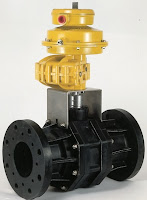 |
| Kinetrol AP Pneumatic Positioner on top of a Kinetrol Vane Actuator |
A valve positioner is an instrument attached to a valve to ensure the valve is at a desired position of opening or closing as per the control signal. Positioners sense the valve position through a position feedback mechanism connected to valve stem. There are many types of valve positioners. Some utilizing pneumatic signals (referred to as pneumatic positioners) and some using electrical current as the signal (referred to as electro-pneumatic positioners). Many manufacturers stake claim over design and performance enhancements, but one pneumatic positioner stands out because of its elegant design. The Kinetrol AP Positioner.
The result is a positioner with unparalleled performance and real industrial robustness, sweet and easy to calibrate and characterize, and adaptable to the whole range of applications with its unbeatable list of options – high flow valves, direct mount or industry standard discrete mount housings, 4-20mA angle retransmit, limit switches, Clear Cone position monitor and I/P convertors (either simple or with various explosion proof options).
20 Innovative & Elegant Engineering Improvements
- ENCLOSURE – robust die-cast metal with tough corrosion-resistant epoxy coating and O-ring sealing. Layout gives easy access to all adjustments on removal of lid.
- LID – shown with optional Clear Cone sealed angle monitor. Epoxy coated die–cast metal held on by four captive screws gives quick access to the interior.
- CARRIER PLATE ASSEMBLIES – integrated assemblies carrying the feedback shaft and cam plus angle retransmit drive and pot (when specified). Easily removed for conversion or maintenance.
- FEEDBACK POT DRIVE – zero backlash, proven trouble free for life.
- OPTIONAL ANGLE RETRANSMIT CIRCUIT – externally powered (8–30v DC) linear 4-20mA feedback, rangable down to 30º for full 4-20mA span. Easily accessible zero and span adjustment.
- RETRANSMIT POT – high quality conductive plastic servo–type with ball bearings. Proven long life and high precision.
- ACTUATOR INTERFACE – options include NAMUR standard (shown), Kinetrol male square or Kinetrol direct mount female square. Quick external conversion allows bracket mounting to any rotary or linear actuator.
- INTERCHANGEABLE PORT PLATES – easily convertible for different flowrate options.
- INTERNAL ANGLE SCALE – with adjustable indicator for easy field calibration.
- EXHAUST SNUBBER SCREWS – allow travel speed reduction down to 1/ 3 x full speed, independently in each direction, by screwing in to restrict exhaust air flow.
- GAUGE PORT – as standard.
- SPAN ADJUSTMENT – quick and easy thumbwheel setting with slotted locking screw.
- ZERO ADJUSTMENT – quick and easy thumbwheel setting with slotted locking screw.
- STRAIGHT–LINE MECHANISM – unique geometry allows cw/ccw change over by simple cam inversion.
- FEEDBACK CAM – quick and easy reversal ( for rotational sense handing) or replacement (to change the response characteristic) of the cam is facilitated by a spring loaded retention device.
- FEEDBACK SHAFT – innovative collet connection permits quick– fit/release of the actuator interface and eliminates backlash.
- 3–TERMINAL DIN PLUG – retrofit-able option available for 4-20mA angle retransmit. Allows fully external connection with rapid connect/disconnect capability.
- AIRFLOW CHANGEOVER BLOCK – allows selection of direction in which positioner moves (for direct mount models).
- SPOOL VALVE – highly reliable, all metal, 5 port proportional valve controls the air flow. Three versions, with different flowrates, are easily interchangeable.
- UNIT IDENTIFICATION – each positioner carries a unique serial number and is CE marked.











